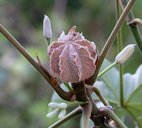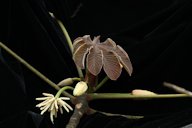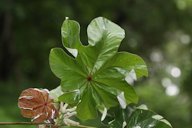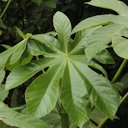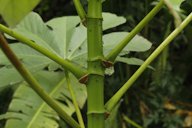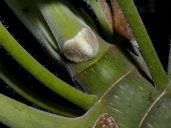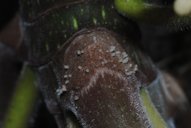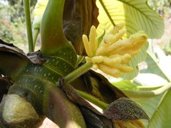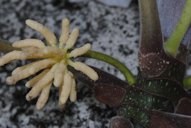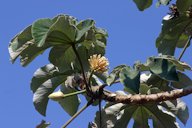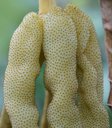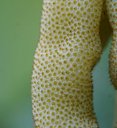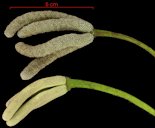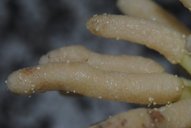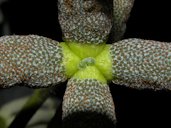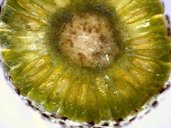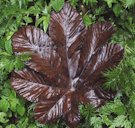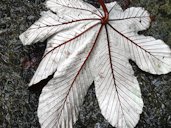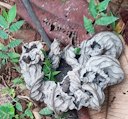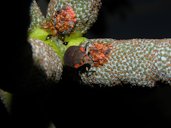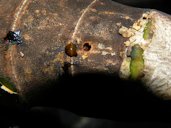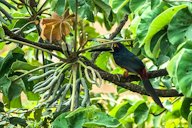| Trumpet Tree - Cecropia peltata | |||||||||||||||||||||||||||||||||||||||||||||||||||||||||||
|---|---|---|---|---|---|---|---|---|---|---|---|---|---|---|---|---|---|---|---|---|---|---|---|---|---|---|---|---|---|---|---|---|---|---|---|---|---|---|---|---|---|---|---|---|---|---|---|---|---|---|---|---|---|---|---|---|---|---|---|
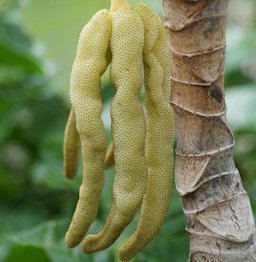 Fig. 1  Cecropia peltata fruit, Largo, FL 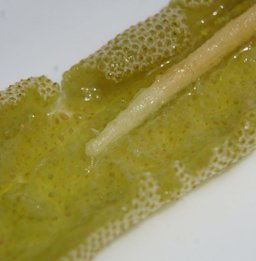 Fig. 2  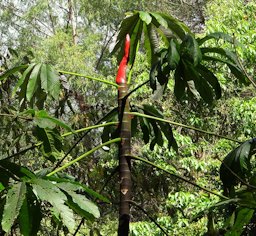 Fig. 3  Yagrumo (C. peltata), Guaraira Repano National Park, Caracas, Venezuela The distinctive red sheath covering the leaf bud 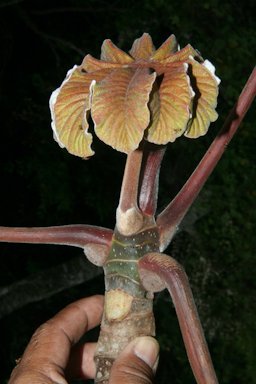 Fig. 4  C. peltata, Costa Rica 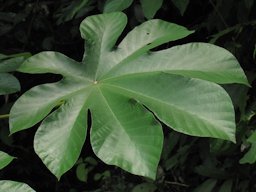 Fig. 5  Trumpet Tree, C. peltata, Antioquia, Colombia 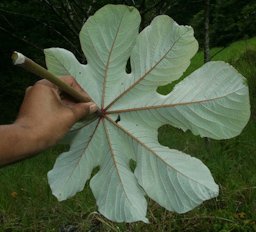 Fig. 6  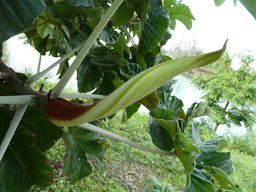 Fig. 16  C. peltata at the Fruit and Spice Park in Homestead, FL 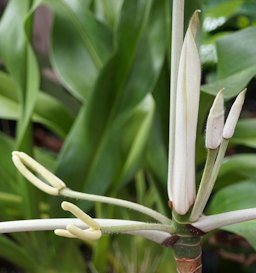 Fig. 17  C. peltata is flowering, Largo, FL Female tree with pistillate flowers 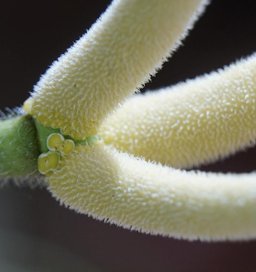 Fig. 18  C. peltata is flowering, Largo, FL 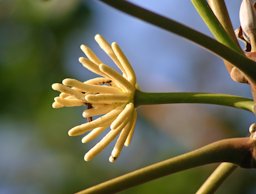 Fig. 19  C. peltata, Quintana Roo, Mexico Male tree with staminate flowers 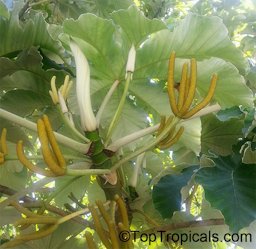 Fig. 23  C. peltata, Cecropia, Yagrumo, Guarumo 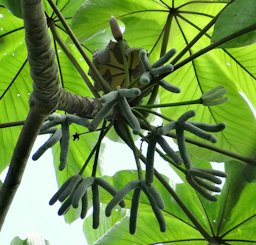 Fig. 24  Yagrumo (C. peltata), La Pomarrosa Farm, Barlovento, north centre Venezuela 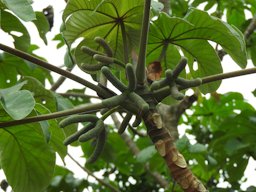 Fig. 25  C. peltata, Playa del Carmen, Mexico 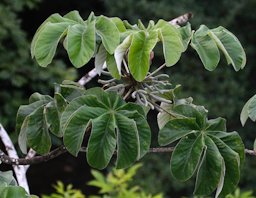 Fig. 32  Trumpet Tree, C. peltata, Canopy Tower, Panama 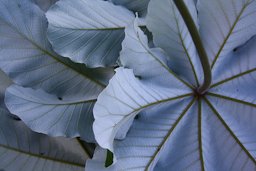 Fig. 33  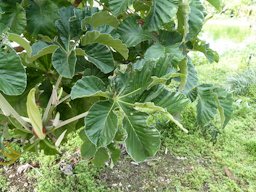 Fig. 34  C. peltata at the Fruit and Spice Park in Homestead, FL 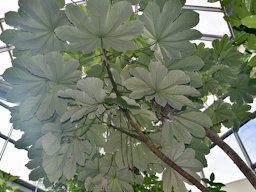 Fig. 35  C. peltata, Trumpet Tree, Palmengarten Frankfurt 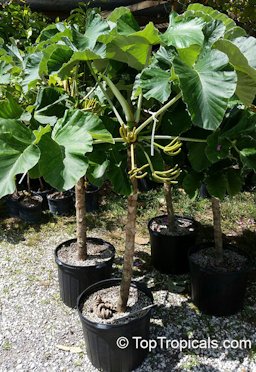 Fig. 39  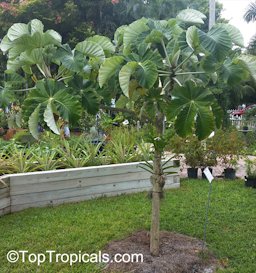 Fig. 40  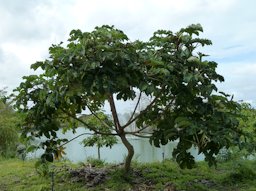 Fig. 41  C. peltata at the Fruit and Spice Park in Homestead, FL 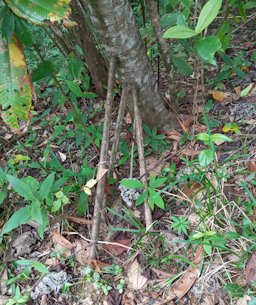 Fig. 42  Trumpet Tree, C. peltata, Mariato District, Panama 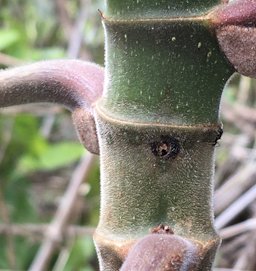 Fig. 43 C. peltata, Guanacaste, Costa Rica 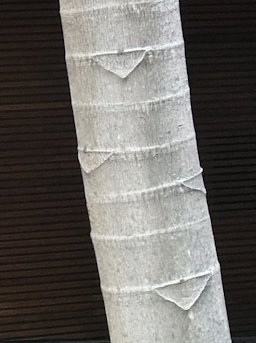 Fig. 44 Trumpet Tree, C. peltata, Bogota, Colombia 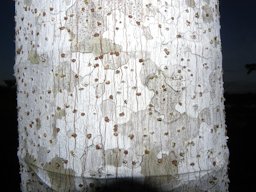 Fig. 45 Charcos, Puntarenas, Costa Rica 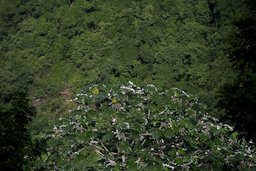 Fig. 46  Yagruma (C. peltata) in the Sierra del Purial 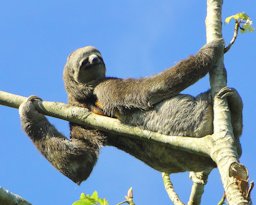 Fig. 47  Sloth, Bradypus variegatus flaccidus on C. peltata, north centre Venezuela |
Scientific
name Cecropia peltata L. Common names English: trumpet-tree, trumpet-wood, pumpwood, snakewood; shield-shaped trumpet-tree; Spanish: yagrumo, llagrumo, grayumo hembra (Puerto Rico); trumpet-wood (Virgin Islands); yaorumo, yagrumo hembra (Dominican Republic); yagruma, yagruma hembra (Cuba); guarumo (Guatemala, Costa Rica, Colombia); igarata (Guatemala); Barbados: pop-a-gun; Trinidad: bois canon; British Guiana: wanasoro, congo-pump; French: bois trompette (Haiti, Guadeloupe), bois canon (Guadeloupe, Martinique); Dutch: wild papaw (West Indies); Surinam: bospapaja 1 Synonyms Ambaiba humboldtiana (Klotzsch) Kuntze, A. peltata (L.) Kuntze, A. propinqua (Miq.) Kuntze, A. schiedeana (Klotzsch) Kuntze, A. surinamensis (Miq.) Kuntze, C. arachnoidea Pittier, C. argentea Vis., C. asperrima Pittier, C. dielsiana Snethl., C. digitata var. grisea Ten. ex Miq., C. goodspeedii Cuatrec., C. hondurensis Standl., C. humboldtiana Klotzsch, C. propinqua Schott ex Miq., C. scabrifolia V.A.Richt., C. schiedeana Klotzsch, C. surinamensis Miq., Coilotapalus peltata Britton, C. peltata Hitchc. 8 Family Urticaceae (nettle family), formerly Cecropiaceae Origin Central America, northern South America, and the Caribbean 2 USDA hardiness zones 9-12 5 Uses Fruit; landscape value; medicinal properties Height It can grow to 70 ft (21 m) tall, but most trees are much smaller 2 Crown Sparsely branched canopy; few stout branches arising high on the trunk 1,5 Plant habit Awkwardly branched at the top of the tree Growth rate Grows very rapidly 2-3 in. (2.5-7.5 cm) in diameter and 2.5 ft (76 cm) vertically per year 1,3 Longevity Short-lived; only 20 years 9 Trunk/bark/branches Stem internodes hollow; solid trunk; grey smooth bark; ringed with leaf scars 1,2,4 Leaves Evergreen; alternate; very large thick umbrella-like (peltate); 1-2 1/2 ft (30-76 cm); clustered at tips of inwardly curving stems; dark green above, felty white underneath 1 Flowers Dioecious; held in paired, finger-like clusters 2,5 Fruit Numerous small seeds embedded in 3 in (7.5 cm) long soft-fleshed fruiting stems 2 Season In flower and fruit probably through the year 1 Light requirement Bright shade to full sun 5 Soil tolerances Sandy, loamy and clay soils; can grow in nutritionally poor soil 9 pH preference Mildly acid; neutral soils 9 Drought tolerance Prefers moist soils; tolerates drought 9 Soil salt tolerance Low 5 Cold tolerance Frost sensitive Roots Sometimes developing prop roots around the base (Fig. 42); shallow root system 1,9 Invasive potential * None reported in Florida; Cecropia obtusifolia is invasive in Malaysia, Africa, and the Pacific Islands Pest resistance Some insects are known to cause some defoliation Known hazard It is wise to be cautious around these trees until you are certain that the ones you are dealing with are ant-free 2 Reading Material Cecropia peltata, PROSEA Foundation Cecropia peltata, Floridata Origin Cecropia peltata is native to Central America, northern South America, and the Caribbean, and it has naturalized in parts of Africa. This is an early-succession species adapted to grow rapidly in disturbed areas. It is therefore most common in secondary woods and along forest edges. 2 Taxonomy The Cecropia genus, formerly placed in its own family Cecropiaceae but now usually placed in the nettle family (Urticaceae), contains more than 60 species in total, all from the Neotropics. 3 Cecropia peltata is often confused with C. palmata, which has leaves divided almost to the base (as opposed to a third of the way in) and longer fruits. C. peltata may also be mistaken for Didymopanax morototoni, an unrelated lookalike tree. 2 Description Cecropia peltata, tends to be more of a fast-growing, short-lived, mammoth herb than a tree. It has a slender trunk, often with stilt roots (Fig. 42) supporting a sparsely branched canopy of soft stems that hold spirals of massive, rounded, palmate, 7-9 lobed leaves. It makes an attractive ornamental because of its dramatic foliage, as well as its intriguing, edible, jelly-like, fingered fruit. 5 A multipurpose tree, it is gathered from the wild for food, medicine and various other uses. A very good pioneer species, it is also occasionally cultivated in gardens in tropical and subtropical areas such as Florida and the West Indies, where they are valued for their large, umbrella-shaped crown of attractive palmate foliage, leaden above, silver-felted beneath (Fig. 6,33). Although short-lived, Cecropia provide a dramatic canopy but cast only very light shade, allowing other plants to be grown right up to the trunk base. 10 It can grow to 70 ft (21 m) tall, but most trees are much smaller. In addition to providing quick (though patchy) shade and tropical atmosphere, the trumpet tree makes a fine ecological conversation piece. 2 This is a very frost sensitive tree that throws a dramatic tantrum and flings big brown leaves all around when it gets chilled. 2
Leaves Leaves are alternate but clustered at ends of branches, each on a stout round green petiole 12-20 inches long, enlarged at base. The leaf blades, rounded in outline, have 7-11 lobes and are peltate (that is, the petiole attaches to a point in the middle of the leaf blade instead of at the edge), the lobes and sinuses rounded. Upper surface is green, slightly rough and hairless, and lower surface with a dense coat of whitish hairs. 1 The smooth gray bark on young trees is ringed with leaf scars (Fig. 44). 2 There is a giant bud covered by a large, pointed, reddish, hairy scale (stipule) 5-10 inches long (Fig. 3). 1
Fig. 7. C. peltata, Quintana Roo, Mexico (new leaf emerging) Fig. 8. C. peltata, Nicaragua Fig. 9. C. peltata, Nicaragua (new leaves in different stages) Fig. 10,11. Trumpet Tree, C. peltata, Chiapas, Mexico Fig. 12. Stipules of C. peltata, Bogor, West Java, Indonesia Flowers Yagrumo hembra is dioecious, with staminate (male) flowers (Fig. 19,20,21) borne in slender, stalked aments 2.0 to 2.4 in. (5 to 6 cm) in length, arranged in clusters of as many as 15, and pistillate (female) flowers (Fig. 17) in thicker, stalkless aments grouped in clusters of only 2 to 5. Both staminate and pistillate trees may be observed in flower and fruit all year long; however, a peak flowering and fruiting period occurs in Puerto Rico during the months of January to March, the drier season. 11 Staminate inflorescences remain on the tree for only 1.5 months and produce copious amounts of wind-borne pollen approximately 1 to 1.5 months following emergence from the terminal bud. 11
Fig. 20. Trumpet Tree, C. peltata, James Hill, Jamaica, male flower Fig. 21. C. peltata male flower Fig. 22. C. peltata, Quintana Roo, Mexico, male flower Pollination The flowers are probably wind-pollinated. 4 Plants are dioecious, both male and female forms must be grown if seed is required. 9 Fruit Soft-flesh fruit are drooping in clusters resembling octopus. They are very tasty, sweet, watery, aromatic. The female trees produce the cylindrical fruits at the end of short stems on the flowering stalks, along with singular white flowers curled into long twists. Each flower will develop an average of four fruits which will contain up to 800 tiny, single-seeded fruits. These fruits, called achenes (like the seeds on the outside of a strawberry), form cylindrical fruit clusters 4-6 in. (10-15 cm) long. When on the tree, Cecropia fruits look like greenish-yellow fingers reaching up to the sky (Fig. 23). As they grow and mature, they grow soft and plump up. The fruits take on a slight grayish-green color, and become pendulous. In the center of the fruits is an inedible straight white stalk that remains once the edible portion is removed. The soft, tender flesh is sweet with a somewhat gelatinous texture and a taste reminiscent of figs. The tiny seeds can either be eaten or discarded. 14 There are 2,500 seeds per gram (70,875/oz), air dried. The extraction factor for seeds is about 20 percent, because of the gummy material surrounding each seed. 11
Fig. 26,27. C. peltata, Largo, FL Fig. 28. Female flowers Fig. 31. C. peltata, Costa Rica, fruit cross section Harvesting Maturation, from emergence of the inflorescence from the terminal bud to full ripening, requires from 3.5 to 4 months. 11 Propagation The trees propagate naturally. The seeds apparently germinate slowly. In Trinidad it was observed that bats eat quantities of the succulent fruits and are the chief agents of seed dispersal. Birds also distribute the seeds. 1 The seeds are also water-dispersed. 4 Seed - best sown in a sunny seedbed as soon as it is ripe. The seed usually starts to sprout within 25-40 days, though germination rates are low. Pot the seedlings up into individual containers when they are 2-2.5 in. (5-6 cm) tall. 7 Planting Yagrumo hembra grows on alluvial, colluvial, and residual soils neutral to acidic in nature. These soils may be derived from tuffs; volcanic rock, andesitic or dioritic in composition; limestone; or serpentine. Soil texture may range from heavy clay to sandy, but a clay-loam soil is optimal. 11 Pests In the seedling and sapling stages a major cause of mortality is defoliation by the larvae of the following: Prepodes spp., Gynaecia dirce, Historis odious, Correbidia terminalis, and Sylepta salicalis. The cotton or melon aphid (Aphis gossypii) is also commonly observed on leaves of yagrumo hembra. 11 Food Uses The fruit is eaten raw, it has a sweet, jelly-like flesh. 5 Cecropia fruits can be dried, and eaten as a snack. The flesh from the fruits is used to make marmalade or jam. Cecropia fruit is highly perishable and can be kept in the refrigerator for a few days. 14 Medicinal Properties ** The leaves of both Cecropia peltata and C. palmata are used in herbal medicine under the name "embauba leaf." 2 The word Embauba comes from Tupi-Guarani, an indigenous language in South America, and means “fruit of the hollowed-out tree”. 14 The sap and leaves of Cecropia peltata are used extensively in traditional medicine in tropical America. Sometimes bark, roots and fruits are also applied. The acrid, bitter and astringent sap is applied externally to treat snakebites, scorpion stings, ulcers, warts and other skin affections. Fresh or dried leaves are traded on the market, and used in decoctions, infusions or as a tincture to treat asthma, bronchitis, coughs, diabetes, diarrhoea, dysentery, fever, influenza, gonorrhoea, oedema, liver complaints, hypertension, Parkinson's disease, nervous disorders, toothache, sore throat, as a cardiac tonic and diuretic, and to expel the placenta after childbirth. The use of leaves in an infusion to treat asthma and rheumatism has been much advocated. 4 Other Uses The wood is whitish, light weight, soft, weak, and brittle, but tough for its weight. It is not durable and is very susceptible by dry-wood termites. Machining characteristics are as follows: planing and sanding are good; shaping and turning are fair; boring is very poor; mortising is poor; and resistance to screw splitting is excellent. 1 In Puerto Rico the wood is used for manufacture of excelsior. Combined with cement, it is made into a type of insulation board for light interior construction and partitions. The wood should be a suitable substitute for balsa in manufacture of toys, models, and other products made from moderately heavy grades of balsa. Elsewhere the wood has been used for matchsticks, boxes and crates, interior boarding, and paper pulp. 1 The hollow stems have been used to make floats for fishnets and life preservers and, when split in two, have served as water troughs and gutters. Substitutes for cork stoppers have been whittled from the soft wood. The fibrous bark of related species was used by Indians for cordage and mats. It is reported that the wood ignites easily from friction and serves as tinder. 1 Discarded brown and bright silver leaves curl up into fantastic contortions as they dry (Fig. 38) and are much prized by florists. 5
Fig. 36. Top side of a fallen leaf of "yagrumo" (C. peltata),El Yunque National Forest. Río Grande, Puerto Rico Fig. 37. Underside of a fallen leaf of "yagrumo" Fig. 38. C. peltata, Mariato District, Panama Ecological As a dominant secondary species, yagrumo hembra is invaluable in regeneration of the forest following disturbance. As it rapidly forms a dense stand, nutrients may be conserved and the environment beneath ameliorated sufficiently to allow species characteristic of a later stage of succession to germinate and grow. In this manner the soil may be stabilized following a disturbance such as a landslide. Its broad canopy protects the soil from excessive erosion and reestablishes shade conditions to the forest floor. 11 Environmental Impact There are few records of impacts on native biodiversity, but no other significant impacts, economic, social or environmental. In addition, as C. peltata is a pioneer species, it may be expected to die out and be replaced in later stages of succession, thus its impacts even on the environment and/or biodiversity could be assumed to be relatively temporary. 12 Azteca Ants and the Cecropia Vegetative morphology of yagrumo hembra throughout the islands of the Caribbean differs from that of mainland (Central and South America) representatives of the same species. On the mainland, yagrumo hembra maintains a symbiotic relationship with Azteca ants. The species Azteca constrictor and A. alfaroi have been reported from Venezuela. There the tree also has adaptations, such as a trichilium or highly modified petiole bases that produce mullerian bodies or food bodies rich in glycogen. The stinging, aggressive ants live in the hollow internodes and feed upon glycogen produced by the tree. Neither the adaptations nor the ants are present on trees in Puerto Rico. 11 Many Cecropias are called myrmecophytes, plants that have a relationship with ants. 13 General Cecropia for Cecrops, first king and builder of Athens. 10 These pioneer trees stand out the wooded slopes of their rich, humid habitat, signaling their presence by the silvery flashes of their foliage (Fig. 46) as it is stirred by the slightest breeze. 5 English and French common names refer to the use of the hollow branches for trumpets or other musical instruments. Also, children sometimes make flutes from the hollow petioles. 1 Native people in Central America and the Amazon traditionally used Pourouma leaves for sandpaper. 6 Cecropias are also very popular with animals, as their fruits, flowers, and leaves provide food to tanagers, cotingas, toucans, monkeys, squirrels, coatis, opossums, bats, iguanas, and especially sloths (Fig. 47). 3 Sloths are said to be everywhere in Costa Rican cloud forests. Each family of sloths has a peculiar dietary preference, and many three-toed sloths seem to have chosen the cecropia’s juicy leaves. Spider Monkeys have been seen at play in the cecropias of Cloudbridge. Many kinds of birds eat, and then disperse, the tree’s thick hanging fruits. Other birds eat the many insects that thrive on the foliage. The Lineated Woodpecker actually pierces young trees and branches to feed on the Azteca ants. 13
Fig. 48. Ardilla alimentándose de los frutos del Yagrumo Fig. 49. Hemiptera, chupando savia de C. peltata Fig. 50. Hormiga, Azteca en C. peltata Fig. 51. Colored aracari, Pteroglossus torquatus List of Growers and Vendors |
||||||||||||||||||||||||||||||||||||||||||||||||||||||||||
| Bibliography 1 Little, Elbert L., and Frank Wadsworth. "Trees of Puerto Rico and The Virgin Islands." Agriculture Handbook no. 229, U.S. Dept. of Agriculture, July 1964. 2 Conway Deuver, Linda, and Steve Christman. "Cecropia peltata." Floridata, no. 846, Published 1 Nov. 2000, Updated 5 July 2006, floridata.com/plant/846. Accessed 5 May 2022. 3 "Cecropia." Canopy Tower Plant Database, 14 Sept. 2020, www.canopytower.com/cecropia/. Accessed 7 May 2022. 4 Hildebrand, J. W. "Cecropia peltata L." Medicinal and poisonous plants 3, Plant Resources of South-East Asia No 12(3), Edited by E. W. M. Lemmens, R. H. M. J. and N. Bunyapraphatsara, PROSEA Foundation, Bogor, Indonesia, record 1530, 2003, PROSEA, (CC BY-NC-SA 3.0), www.prota4u.org/prosea/view.aspx?id=2467. Accessed 7 May 2022. 5 Barwick, Margaret. Tropical & Subtropical Trees. A Worldwide Encyclopaedic Guide. London, 2004. 6 Shumway, S. W., et al. "Cecropiaceae, Snake Wood Family." RainforestPlants, 2009, wikis.wheatonma.edu/rainforest/index.php?title=Cecropiaceae&oldid=3599. Accessed 19 May 2022. 7 Lorenzi, Harri. Brazilian Trees, A Guide to the Identification and Cultivation of Brazilian Native Trees. Vol. 1. 4th ed., Nova Odessa, Instituto Plantarum de Estudos da Flora, 2002. 8 "Cecropia peltata synonyms." World Flora Online, WFO (2022), www.worldfloraonline.org/taxon/wfo-0000592298. Accessed 19 May 2022. 9 "Cecropia peltata." Plants For A Future, PFAF, pfaf.org/user/Plant.aspx?LatinName=Cecropia+peltata. Accessed 20 May 2022. 10 The New Royal Horticulture Society Dictionary of Gardening. Vol. 1, A to C, Edited by Anthony Huxley, et al, London, MacMillan Reference, 1999. 11 Silander, Susan R., and Ariel E. Lugo. "Yagrumo Hembra, Trumpet-Tree, Cecropia peltata L." USDA, Forest Service, (CC-BY-NC), www.srs.fs.usda.gov/pubs/misc/ag_654/volume_2/cecropia/peltata.htm. Accessed 20 May 2022. 12 "Cecropia peltata (trumpet tree)." CABI, Invasive Species Compendium, www.cabi.org/isc/datasheet/11955#tosummaryOfInvasiveness. Accessed 24 May 2022. 13 "The Cecropia Tree." Cloudbridge Nature Reserve, Nature Notes no. 7, www.cloudbridge.org/wp-content/uploads/2011/11/NatureNotesNo8.pdf. Accessed 24 May 2022. 14 "Cecropia Fruit." Specialty Produce, www.specialtyproduce.com/produce/Cecropia_Fruit_15093.php. Accessed 25 May 2022. Video V1 "Cecropia tree & pioneer plants / El Guarumo y las plantas pioneras." Eco Planet Films, 25 Jan. 2018, (CC0), www.youtube.com/watch?v=0nGE_TVplfQ. Accessed 23 May 2022. Photographs Fig. 1,2,26,27 Molodchenko, Svetlana. "Cecropia peltata fruit, Largo, FL." Botanical Diversity, April 27, 2021, Instagram, www.instagram.com/p/CSKswNnLFk2/. Accessed 18 May 2022. Fig. 3 barloventomagico. "Yagrumo (Cecropia peltata), Guaraira Repano National Park, Caracas, Venezuela" Flickr, 9 May 2015, (CC BY-NC-ND 2.0), www.flickr.com/photos/barloventomagico/17317071979. Accessed 5 May 2022. Fig. 3,43 Janzen, Daniel H. "Cecropia peltata L." Guanacaste Dry Forest Conservation Fund, via Bold Systems, 2011, (CC BY-NC-SA 4.0), GBIF, www.gbif.org/occurrence/2250943718. Accessed 22 May 2022. Fig. 5 Janzen, Daniel H. "Cecropia peltata L." Guanacaste Dry Forest Conservation Fund, via Flickr, 2011, EOL, (CC-BY-NC-SA-3.0), eol.org/media/11733357. Accessed 22 May 2022. Fig. 6 Janzen, Daniel H. "Cecropia peltata L." Guanacaste Dry Forest Conservation Fund, via Flickr, 2011, EOL, (CC-BY-NC-SA-3.0), eol.org/media/11733358. Accessed 22 May 2022. Fig. 7 Fitzgerald, Dan. "Trumpet Tree, Cecropia peltata, Quintana Roo, Mexico." iNaturalist, Research Grade, 11 May 2021, (CC BY-NC-ND 4.0), www.inaturalist.org/observations/78393872. Accessed 19 May 2022. Fig. 8 Montiel, O. M. "Cecropia peltata, Nicaragua." World Flora Online, no. 28530, WFO (2022), (CC BY-NC-SA 3.0), www.worldfloraonline.org/taxon/wfo-0000592298. Accessed 19 May 2022. Fig. 9 Coronado,Indiana. "Cecropia peltata, Nicaragua." World Flora Online, no. 6234, WFO (2022), (CC BY-NC-SA 3.0), www.worldfloraonline.org/taxon/wfo-0000592298. Accessed 19 May 2022. Fig. 10,11 arthur_cm. "Trumpet Tree, Cecropia peltata, Chiapas, Mexico." iNaturalist, Research Grade, 31 Mar. 2022, (CC BY-NC-ND 4.0), Image cropped, www.inaturalist.org/observations/110012384. Accessed 18 May 2022. Fig. 12 Djatmiko, Wibowo. "Stipules of Cecropia peltata, Bogor, West Java, Indonesia." Wikimedia Commons, 12 Oct. 2014, (CC BY-SA 3.0), (GFDL), commons.wikimedia.org/wiki/File:Cecro_pelta_141012-0330_tdp.JPG. Accessed 16 May 2022. Fig. 13 Aguilar, Reinaldo. "Cecropia peltata L." Vascular Plants of the Osa Peninsula, Costa Rica, 7 Jan. 2013, Flickr, (CC BY-NC-SA 2.0), www.flickr.com/plantaspeninsulaosa/8481094691/in/photostream/. Accessed 20 May 2022. Fig. 14 Aguilar, Reinaldo. "Cecropia peltata L." Vascular Plants of the Osa Peninsula, Costa Rica, 7 Jan. 2013, Flickr, (CC BY-NC-SA 2.0), www.flickr.com/plantaspeninsulaosa/8481094807/in/photostream/. Accessed 20 May 2022. Fig. 15,,21,29 Monro, Alex. "Cecropia peltata, Costa Rica." World Flora Online, no. 6829, WFO (2022), (CC BY-NC-SA 3.0), www.worldfloraonline.org/taxon/wfo-0000592298. Accessed 19 May 2022. Fig. 16 Cutler, Wendy. "Cecropia peltata at the Fruit and Spice Park in Homestead, FL." Flickr, 6 Feb. 2012, (CC BY 2.0), www.flickr.com/photos/wlcutler/6879364149. Accessed 7 May 2022. Fig. 17,18 Molodchenko, Svetlana. "Cecropia peltata is flowering, Largo, FL." Botanical Diversity, 4 Aug. 2021, Instagram, www.instagram.com/p/CSKswNnLFk2/. Accessed 18 May 2022. Fig. 19,22 Bohn, Klaus. "Trumpet Tree, Cecropia peltata, Quintana Roo, Mexico." iNaturalist, Research Grade, 2 Jan. 2020, (CC BY-NC-ND 4.0), Image cropped, www.inaturalist.org/observations/37191536. Accessed 18 May 2022. Fig. 20 Franck, Alan R. "Trumpet Tree, Cecropia peltata, James Hill, Jamaica." iNaturalist, Research Grade, 25 June 2020, (CC BY-NC-ND 4.0), www.inaturalist.org/observations/50953507. Accessed 18 May 2022. Fig. 23,39,40 "Cecropia peltata, Cecropia, Yagrumo, Guarumo." Top Tropicals, toptropicals.com/catalog/uid/Cecropia_peltata.htm. Accessed 18 May 2022. Fig. 24 barloventomagico. "Yagrumo (Cecropia peltata), La Pomarrosa Farm, Barlovento, north centre Venezuela." Flickr, 20 Sept. 2014, (CC BY-NC-ND 2.0), www.flickr.com/photos/barloventomagico/15165326349. Accessed 5 May 2022. Fig. 25 Guardiola, Janet. "Trumpet Tree, Cecropia peltata, Playa del Carmen, Mexico." iNaturalist, Research Grade, 22 Jan. 2020, (CC BY-NC-ND 4.0), www.inaturalist.org/observations/37863493. Accessed 18 May 2022. Fig. 28 Paton, Steve. "Cecropia peltata flower." Environmental Sciences Program, Smithsonian Tropical Research Institute, Digital File Manager, no. 7782, STRI, biogeodb.stri.si.edu/bioinformatics/dfm/metas/view/7782. Accessed 16 May 2022. Fig. 30 Aguilar, Reinaldo. "Cecropia peltata L." Vascular Plants of the Osa Peninsula, Costa Rica, 7 Jan. 2013, Flickr, (CC BY-NC-SA 2.0), www.flickr.com/photos/56339362@N03/8481095535. Accessed 20 May 2022. Fig. 31 Aguilar, Reinaldo. "Cecropia peltata L." Vascular Plants of the Osa Peninsula, Costa Rica, 7 Jan. 2013, Flickr, (CC BY-NC-SA 2.0), www.flickr.com/photos/56339362@N03/13905106048. Accessed 20 May 2022. Fig. 32 Mainguy, Gaell. "Trumpet Tree, Cecropia peltata, Canopy Tower, Panama." iNaturalist, Research Grade, 10 Feb. 2021, (CC BY-NC-ND 4.0), www.inaturalist.org/observations/69360162. Accessed 18 May 2022. Fig. 33 Torres, Fernanda. "Cecropia peltata." Flickr, 25 Apr 2010, (CC BY-NC-ND 2.0), www.flickr.com/photos/36366564@N06/4616362567/. Accessed 5 May 2022. Fig. 34 Cutler, Wendy. "Cecropia peltata at the Fruit and Spice Park in Homestead, FL." Flickr, 6 Feb. 2012, (CC BY 2.0), www.flickr.com/photos/wlcutler/6879361261. Accessed 7 May 2022. Fig. 35 NasserHalaweh. "Cecropia peltata, Trumpet Tree, Palmengarten Frankfurt." Wikimedia Commons, 31 Oct. 2017, (CC BY-SA 4.0), commons.wikimedia.org/wiki/File:Urticaceae_Cecropia_peltata_1.jpg. Accessed 16 May 2022. Fig. 36 LBM1948. "Top side of a fallen leaf of "yagrumo" (Cecropia peltata),El Yunque National Forest. Río Grande, Puerto Rico." Wikimedia Commons, 29 Oct. 2013, (CC BY-SA 4.0), commons.wikimedia.org/wiki/File:El_Yunque_N.F._23.jpg. Accessed 16 May 2022. Fig. 37 LBM1948. "Underside of a fallen leaf of "yagrumo" (Cecropia peltata),El Yunque National Forest. Río Grande, Puerto Rico." Wikimedia Commons, 29 Oct. 2013, (CC BY-SA 4.0), commons.wikimedia.org/wiki/File:El_Yunque_N.F._34.jpg. Accessed 16 May 2022. Fig. 38,42 loes. "Trumpet Tree, Cecropia peltata, Mariato District, Panama." iNaturalist, Research Grade, 28 Nov. 2021, (CC BY-NC-ND 4.0), Images cropped, www.inaturalist.org/observations/102128102. Accessed 18 May 2022. Fig. 41 Cutler, Wendy. "Cecropia peltata at the Fruit and Spice Park in Homestead, FL." Flickr, 6 Feb. 2012, (CC BY 2.0), www.flickr.com/photos/wlcutler/6879358089. Accessed 7 May 2022. Fig. 43 Crawford, Andrew J. "Trumpet Tree, Cecropia peltata, Guanacaste, Costa Rica." iNaturalist, Research Grade, 2 Mar. 2020, Public Domain, www.inaturalist.org/observations/39468712. Accessed 18 May 2022. Fig. 44 de Roux, Juan Manuel. "Trumpet Tree, Cecropia peltata, Bogota, Colombia." iNaturalist, Research Grade, 10 Nov. 2019, (CC BY-NC-ND 4.0), www.inaturalist.org/observations/35523333. Accessed 18 May 2022. Fig. 45 Aguilar, Reinaldo. "Cecropia peltata, Charcos, Puntarenas, Costa Rica." Vascular Plants of the Osa Peninsula, Costa Rica, via Flickr, ID ec862a95b8083178a54f3b5c660b4a15, EOL, (CC-BY-NC-SA), eol.org/media/13808405. Accessed 22 May 2022. Fig. 46 Christian Pirkl. "Yagruma (Cecropia peltata) in the Sierra del Purial." Wikimedia Commons, 7 July 2014, (CC BY-SA 4.0), commons.wikimedia.org/wiki/File:Yagruma_(cecropia_peltata)_in_the_Sierra_del_Purial.jpg. Accessed 16 May 2022. Fig. 47 barloventomagico. "Pereza de Tres Dedos [Sloth] (Bradypus variegatus flaccidus) en un Yagrumo (Cecropia peltata), La Pomarrosa Farm, Barlovento, north centre Venezuela." Flickr, 4 Jan. 2011, (CC BY-NC-ND 2.0), www.flickr.com/photos/barloventomagico/5332415172. Accessed 5 May 2022. Fig. 48 Vanegas, Ymmer. "Ardilla alimentándose de los frutos del Yagrumo (Cecropia peltata)." Wikimedia Commons, 13 Aug. 2013, (CC BY-SA 4.0), commons.wikimedia.org/wiki/File:Ardilla_sobre_un_Yagrumo.JPG. Accessed 16 May 2022. Fig. 49 Aguilar, Reinaldo. "Hemiptera, chupando savia de Cecropia peltata L." Vascular Plants of the Osa Peninsula, Costa Rica, 7 Jan. 2013, Flickr, (CC BY-NC-SA 2.0), www.flickr.com/photos/56339362@N03/8481094119. Accessed 20 May 2022. Fig. 50 Aguilar, Reinaldo. "Hormiga, Azteca en Cecropia peltata L." Vascular Plants of the Osa Peninsula, Costa Rica, 7 Jan. 2013, Flickr, (CC BY-NC-SA 2.0), www.flickr.com/plantaspeninsulaosa/8481094403/in/photostream/. Accessed 20 May 2022. Fig. 51 Hauenstein, Urs. "Colored aracari, Pteroglossus torquatus." Nature Images, 6 Aug. 2017, nature-images.org/plants/trees/cecropia-peltata-tree/. Accessed 23 May 2022. * UF/IFAS Assessment of Non-native Plants in Florida's Natural Areas ** Information provided is not intended to be used as a guide for treatment of medical conditions. Published 6 Apr. 2021 LR |
|||||||||||||||||||||||||||||||||||||||||||||||||||||||||||
